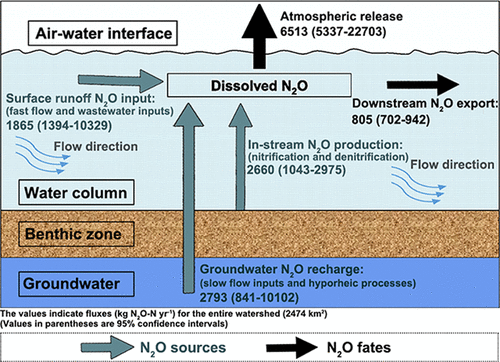当前位置:
X-MOL 学术
›
Environ. Sci. Technol.
›
论文详情
Our official English website, www.x-mol.net, welcomes your
feedback! (Note: you will need to create a separate account there.)
Modeling Riverine N2O Sources, Fates, and Emission Factors in a Typical River Network of Eastern China
Environmental Science & Technology ( IF 10.8 ) Pub Date : 2021-09-14 , DOI: 10.1021/acs.est.1c01301 Minpeng Hu 1, 2 , Bingqing Li 1, 2 , Kaibin Wu 1, 3 , Yufu Zhang 1, 2 , Hao Wu 1, 2 , Jia Zhou 1, 2 , Dingjiang Chen 1, 2, 3
Environmental Science & Technology ( IF 10.8 ) Pub Date : 2021-09-14 , DOI: 10.1021/acs.est.1c01301 Minpeng Hu 1, 2 , Bingqing Li 1, 2 , Kaibin Wu 1, 3 , Yufu Zhang 1, 2 , Hao Wu 1, 2 , Jia Zhou 1, 2 , Dingjiang Chen 1, 2, 3
Affiliation

|
Estimates of riverine N2O emission contain great uncertainty because of the lack of quantitative knowledge concerning riverine N2O sources and fates. Using a 3.5-year record of monthly N2O measurements from the Yongan River network of eastern China, we developed a mass-balance model to address the riverine N2O source and sink processes. We achieved reasonable model efficacies (R2 = 0.44–0.84, Nash–Sutcliffe coefficients = 0.40–0.80) across three tributaries and the entire river system. Estimated riverine N2O loads originated from groundwater (38–88%), surface runoff (3–26%), and in-stream production (4–48%). Estimated in-stream losses via atmospheric release + complete denitrification accounted for 76, 95, 25, and 89% of riverine N2O fate for the agricultural, residential, forest, and entire river system, respectively. Considering limited complete denitrification, the model estimated an upper-bound riverine N2O emission rate of 2.65 ton N2O–N km–2 year–1 for the entire river system. Riverine N2O emission estimates were of comparable magnitude to those estimated with a power-law scaling model. Riverine N2O emissions using the IPCC default emission factor (0.26%) overestimated emissions by 3–15 times, whereas the dissolved N2O concentration-based emission factor overestimated or underestimated emissions. This study highlights the importance of combining comprehensive information on N2O sources and fates to achieve accurate riverine N2O emission estimates.
更新日期:2021-10-06











































 京公网安备 11010802027423号
京公网安备 11010802027423号